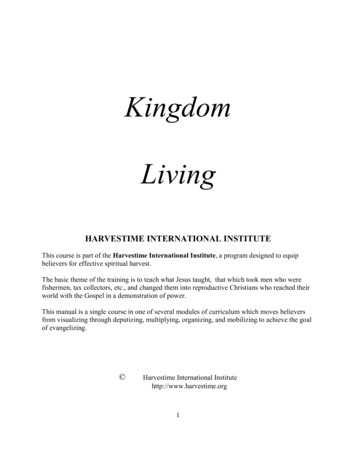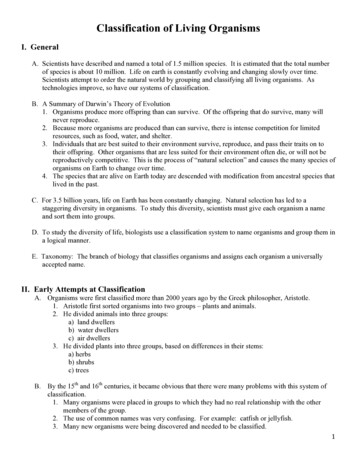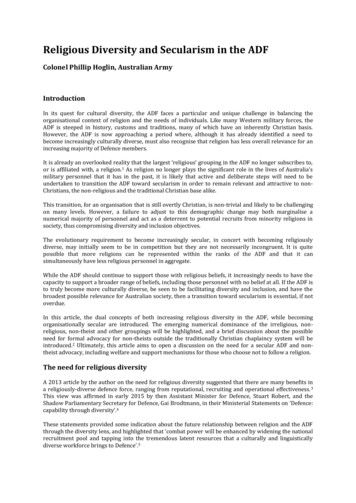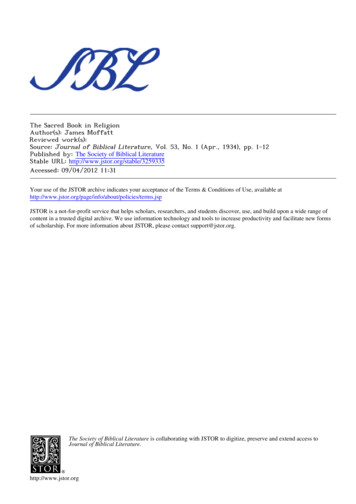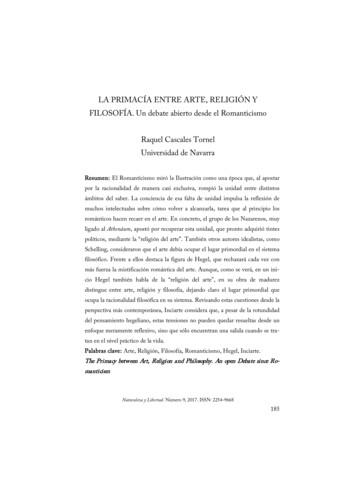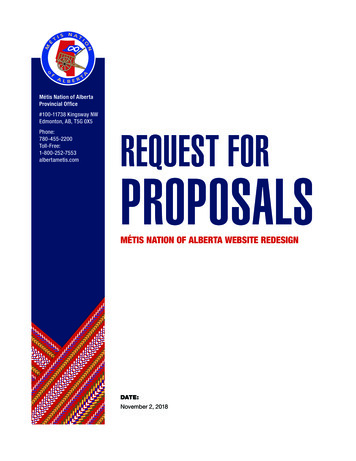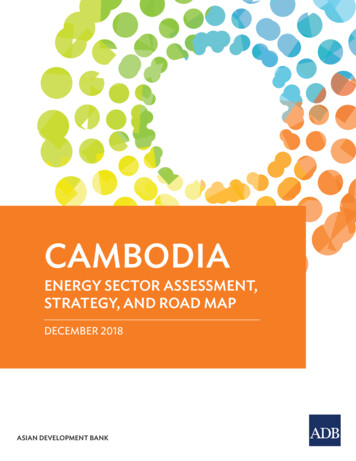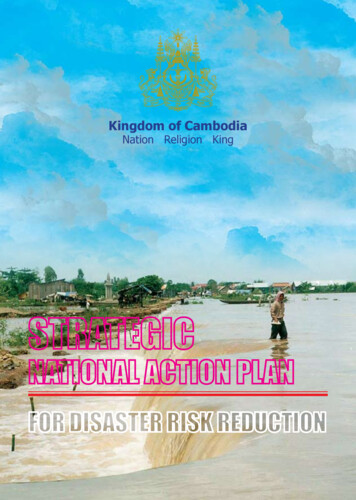
Transcription
Kingdom of CambodiaNation Religion King
Kingdom of CambodiaNation Religion KingSTRATEGIC NATIONAL ACTION PLANFOR DISASTER RISK REDUCTION2008 2013Cooperation betweenNational Committee for Disaster Management andMinistry of Planning2008
Strategic National Action Plan for Disaster Risk ReductionLIST OF ACRONYMS AND ALWFMOAFFMOLMUPCMOEMOEFMOHAction Contra La FaimAsian Development BankAsian Disaster Preparedness CentreASEAN Regional Program for Disaster ManagementAssociation of South East Asian NationsAustralian Agency for International DevelopmentCooperative for Assistance and Relief EverywhereCommunity-Based Disaster Risk ManagementCommon Country AssessmentCommune Committee for Disaster ManagementCenter for Research on the Epidemiology of DisastersCambodian Red CrossChurch World ServiceDamage and Needs AssessmentDanish International Development AssistanceDistrict Committee for Disaster ManagementDepartment for International DevelopmentDisaster Preparedness Programme European CommissionHumanitarian Aid DepartmentDisaster Management Information SystemDisaster Management PlanDisaster Risk ManagementDisaster Risk ReductionEarly Warning SystemFood for WorkFlood Management and Mitigation ProgramDeutche Gesselschaft fur Technische ZusammeinarbeitGlobal Humanitarian PlatformHumanitarian Accountability NetworkHuman Development IndexHyogo Framework for ActionHealth Sector Support ProjectInternational Federation of Red CrossInternational Decade for Natural Disaster ReductionInternational Strategy for Disaster ReductionJapan International Cooperation AgencyLutheran World FederationMinistry of Agriculture, Forestry and FisheriesMinistry of Land Management, Urban Planning and ConstructionMinistry of EnvironmentMinistry of Economy and FinanceMinistry of Healthii
MTUNDPUN/ISDRUSAIDVCAWCDRWFPWHOWVZOAStrategic National Action Plan for Disaster Risk ReductionMinistry of InteriorMinistry of PlanningMinistry of Women AffairsMinistry of Water Resources and MeteorologyMinistry of Education, Youth and SportsMinistry of Rural DevelopmentMinistry of Public Works and TransportsMinistry of InformationMekong River CommissionNational Adaptation Programme of Action to Climate ChangeNon Government OrganizationOxford Committee for Famine ReliefProvincial Committee for Disaster ManagementPartnership for Disaster Reduction – South East AsiaProject in Support of Democratic Development throughDecentralization and DeconcentrationRegional Flood Management and Mitigation CenterRegional Consultative CommitteeRoyal Government of CambodiaStrategic National Action PlanStandard Operating ProcedureTonle Sap Basin AuthorityUnited Nations Development Assistance FrameworkUnited Nations Disaster Management TeamUnited Nations Development ProgramUnited Nations International Strategy for Disaster ReductionUnited States Agency for International DevelopmentVulnerability and Capacity AssessmentWorld Conference on Disaster ReductionWorld Food ProgrammeWorld Health OrganizationWorld VisionVluchtelingen Zorg
Strategic National Action Plan for Disaster Risk ReductionivTABLE OF CONTENTSForewordList of Acronyms and AbbreviationsTable of undPurpose and ObjectivePlanning ProcessLinkages with National Development Policies and .2.1.7.2.2.DISASTER RISK IN CAMBODIAHazard ProfileFloodsDroughtDisease Outbreaks and EpidemicsStormsForest and Land FiresClimate ChangeTechnological DisastersUnderlying Vulnerabilities4567889993.3.13.2NATIONAL STRATEGY OF DISASTER MANAGEMENT ANDDISASTER RISK .34.2.44.3ACTION PLAN FOR DISASTER RISK REDUCTIONDisaster Risk Reduction FrameworkDRR PrioritiesCritical PrioritiesFirst Level PrioritiesSecond Level PrioritiesThird Level PrioritiesSummary of Disaster Risk Reduction Priority Implementation MechanismInstitutional ArrangementsFundingMonitoring and Evaluation23242525
Strategic National Action Plan for Disaster Risk ReductionvList of AnnexesAnnexAnnexAnnexAnnexABCDAnnex EMatrix of DRR Status, Interventions and PrioritiesDisaster TerminologySummary of the Hyogo Framework for Action (HFA)Resolution establishing the inter-ministerial SNAP task force27364142References46List of TablesTable 1. Summary Natural Disaster in Cambodia, 1987-2007Table 2. Summary Disaster Risk Reduction Priority Projects421List of FiguresFigure 1.Figure 2.Figure 3.Map of Flood-prone CommunesMap of Drought-prone CommunesDRM Coordinating Mechanism6724
Published under the project on “Development and Production of the Strategic NationalAction Plan (SNAP) for Disaster Risk Reduction in the context of the HFA for Cambodia”With technical support from the Asian Disaster Preparedness Center (ADPC) and financialassistance from the European Commission Humanitarian Aid department (ECHO)through International Strategy for Disaster Reduction (ISDR)National Committee for Disaster Management (NCDM)European Commission Humanitarian Aid Department (ECHO)Asian Disaster Preparedness Center (ADPC)International Strategy for Disaster Reduction (ISDR)
Strategic National Action Plan for Disaster Risk Reduction1.INTRODUCTION1.1.Background1The United Nations proclamation of the “International Decade for Natural DisasterReduction (IDNDR)” in 1990, the “Yokohama World Conference on Natural DisasterReduction” in 1994, the IDNDR successor “International Strategy for Disaster Reduction(ISDR)” in 2000 and more recently the “Hyogo World Conference on Disaster Reduction”in 2005, have ushered a major shift in the understanding and practice of disastermanagement around the world. While disaster response capacities are still regardedas vital, there is now global recognition and acceptance of the concept and practice ofdisaster risk reduction or disaster reduction.In January 2005, one hundred and sixty-eight nations including the Royal Governmentof Cambodia (RGC) participated in the World Conference on Disaster Reduction (WCDR)held in Kobe, Japan, organized by the UN-ISDR. This meeting resulted in a resolutionfor the implementation of a 10-year international disaster risk reduction strategy, theHyogo Framework for Action (HFA). The HFA sets out three strategic goals and outlinesfive priorities for action, which cover the main areas of disaster risk reduction.At the follow-up Beijing Action for Disaster Reduction in Asia Conference in 2005, it wasresolved that countries in Asia should develop national action plans for disaster riskreduction to comply with the principles of the HFA, establish action plans for buildingcapacities at the national and community levels, and manage the administrative andinfrastructure systems in order to deal with the impact of disasters. It was recommendedthat the national action plans for disaster risk reduction should address the mainpriorities under the HFA.To address the implementation of the HFA in Cambodia, the National Committee forDisaster Management (NCDM) and the Ministry of Planning (MOP) established aninter-institutional task force to spearheaded the formulation of a “Strategic Nationalaction plan for Disaster Risk Reduction 2008 – 2015” (SNAP) for the Royal Government ofCambodia (RGC). Technical assistance was provided by the Asian Disaster PreparednessCenter (ADPC) with funding support from the United Nations International Strategyfor Disaster Reduction (UNISDR) and the Disaster Preparedness Programme of theEuropean Commission Humanitarian Aid Department (DIPECHO).1.2.Purposes and ObjectivesThe primary motivation of the Royal Government of Cambodia in the formulation ofan Action Plan for Disaster Risk Reduction (DRR) is to reduce the vulnerability of itspeople, especially the poor, to the effects of natural, environmental and human-inducedhazards. This can best be achieved by strengthening the disaster management system
Strategic National Action Plan for Disaster Risk Reduction2in Cambodia and by incorporating a disaster risk reduction perspective into the policies,strategies and plans of government in all sectors and at all levels. The action plan wasconceived and formulated to serve as the “road map” or guide for strengthening andundertaking disaster risk reduction in Cambodia. Implementation of the activities andprojects identified in the plan can contribute significantly to the attainment ofgovernment’s primary objective of poverty reduction.The action plan has the following specific objectives:1. Contribute to a common understanding, knowledge and awareness of disasterrisk reduction2. Provide a comprehensive framework to guide and monitor the implementationof disaster risk reduction initiatives in the country3. Create a conducive environment for the mainstreaming of disaster risk reductioninto development plans, policies and projects of the government4. Enhance coordination and cooperation between disaster management anddevelopment stakeholders5. Improve the efficiency of resource allocation and utilisation in disaster reduction6. Orient donor support in disaster risk reduction to government-identified priorities1.3.Planning ProcessThis action plan was developed through a government-led participatory process thatinvolved getting the views and opinion of different disaster management stakeholders inthe country including disaster management officials from local governments (provincial,district and commune levels), local and international NGOs, and institutional donoragencies. Facilitation of this process was overseen by an inter-institutional task forcecreated through an NCDM resolution (Annex C). The task force is chaired by the NCDMand the MOP as deputy chair, with the former providing secretariat support. Five (5)sub-groups were created to facilitate the work of the task force, namely: Sub-group1: Policy and legislation, Sub-group 2: Risk assessment and early warning, Sub-group3: DRR Knowledge management, Sub-group 4: DRR applications, and Sub-group 5:Disaster preparedness and response.A stock-taking exercise was first undertaken to compile data and information on pastand current DRR initiatives in the country, through a survey (Annex D) and varioussecondary information sources and a matrix of DRR initiatives which formulated by themulti stakeholders. A series of extensive consultation meetings was then conductedwith various DRR stakeholder groups to validate findings of the stock-taking exercise,discuss perceived policy and operational gaps and to gather suggestions andrecommendations. With inputs gathered from these consultations guiding their analysis,the Task Force conducted a series of internal meetings in order to decide on nationalstrategic priorities.
Strategic National Action Plan for Disaster Risk Reduction3Several drafts of the SNAP for DRR were reviewed and revised based on discussions withsenior officials of relevant government ministries, international and local non-governmentorganizations and key donor institutions. A final consultation was conducted througha National Consultation Workshop conducted on the 21st of April 2008 followed bythe final review by the inter-institutional task force. The SNAP document was formallyendorsed and launched by the national government in 2009.1.4.Linkages with National Development Policies and PlansCambodia is one of the most disaster affected countries in all of South East Asia and theimpact of these disasters is most felt in the rural areas where it is estimated that 80%of the poor reside (CSES, 2004). Over the last 10 years, Cambodia has been affectedby a series of exceptional floods and by widespread but highly localized agriculturaldroughts. As a result, the government has become aware that without serious efforts inrisk reduction, disasters will increasingly become a serious obstacle to the achievementof the country’s development aspirations, particularly to its highest priority of povertyreduction.The country’s National Poverty Reduction Strategy (NPRS) explicitly identifies naturaldisasters, particularly flood and drought, as critical factors that has, and continuesto, increase socio-economic vulnerabilities of the rural poor, including placing adisproportionate burden of coping with the effects of disasters on women.The National Strategic Development Plan (NSDP) for 2006 -2010, which synthesizesthe goals and objectives of Rectangular Strategy, NPRS and the Cambodia MillenniumDevelopment Goals (CMDG), does not directly address disaster risk reduction butincorporates it in the areas of social welfare, water resource management, agricultureand rural development. Within these priority sectors the disaster risk reduction activitiesidentified include the protection of rural areas from natural hazards of flood and drought,enabling communities for disaster preparedness and risk reduction, and reducingthe vulnerability of the poor to the external shocks including natural hazards. (NSDP,Chapter IV: Key Strategies and Actions).In 2006, the government approved the National Adaptation Program of Action toClimate Change (NAPA). Both this action plan and the NAPA seek to address communityvulnerability to hazards although adaptation to climate change focuses on respondingto extreme weather events and slow-onset changes in climate, whereas disaster riskreduction focuses on wider issues, not just on climate-related disasters. Hence, the actionplan fully supports the NAPA and efforts to synergize implementation and monitoring ofboth plans is one of the activities identified in this action plan to be undertaken.Despite a number of key government policies and pronouncements recognizing theimportance of disaster risk reduction, the actual practice of government institutionsand local governments remain focused primarily on responding after the occurrence of
Strategic National Action Plan for Disaster Risk Reduction4a disaster event. The action plan facilitates the identification of disaster risk reductionactivities of the various government ministries and agencies and consolidates them intoa single comprehensive program of action.2.DISASTER RISKS IN CAMBODIA2.1.Hazard ProfileThe main natural hazard to which Cambodia is exposed to is floods followed by drought,occasional epidemics and storms. During the twenty years period from 1987 to 2007,floods have affected the greatest number of people and caused the greatest amount ofdamage. Floods have also been the cause of the greatest number of fatalities followedby epidemics. The occurrence of drought, on the other hand, has the potential to affecta large number of the population given the lasting agricultural and economic impact,as well as the adverse effect on those dependent upon goods and services from thedrought-affected region. Fortunately, the occurrence of droughts in the country is lessfrequent than floods. The table below gives a summary of the natural disasters thathave occurred in the country during the period 1987 to 2007.Table 1. Summary Natural Disasters in Cambodia, 1987-2007No. ofEventsFloodKilled12avg. per eventDrought5avg. per eventEpidemic8avg. per e USD (in 00413,5700990051,6960EM-DAT: The OFDA/CRED International Disaster Database, www.em-dat.net - Universitécatholique de Louvain - Brussels - BelgiumIt is significant to note, however, that drought periods have been increasingly followedby a destructive flood. Successions and combinations of droughts and floods haveresulted in a significant number of fatalities and considerable economic losses. Theprovinces that are prone to both flooding and drought are Prey Veng, Kandal, KampongCham, Svay Rieng Banteay Meanchey and Kampong Speu.
Strategic National Action Plan for Disaster Risk Reduction52.1.1. FloodsCambodia’s vast flood plain is one of the country’s most prominent geographicalfeatures. This makes large portions of the country naturally susceptible to annualflooding particularly along the Tonle Sap and Mekong river watersheds. The floods haveboth beneficial and harmful effects. Floods have a beneficial impact on agro-basedlivelihoods (e.g., improve soil moisture, fertility for agriculture, ground and surfacewater recharge and provide ecological benefit for fisheries) upon which hundreds ofcommunities depend upon for their livelihood. In certain years, however, floodingbecomes excessive and results to the loss of human life, destruction of crops andlivestock, and damages to homes and the already fragile network of communityinfrastructure (e.g. schools, health centers, local roads and bridges).There are two major flood types in Cambodia:1. Mekong flood – Cumulative rainfall in the upper catchments throughout therainy season causes a slow but steady rise in water levels lasting for severaldays. This can be aggravated by two factors. First, when this combines withheavy rains around the Tonle Sap Lake, which affect the provinces aroundthe lake and the southern provinces. Secondly, the most severe floods occurwhen heavy rains coincide with the arrival of tropical depressions and storms.Mekong river floods are common occurrences in the provinces of Stung Treng,Kratie, Kampong Cham, Prey Veng, Svay Rieng, Kandal, and Takeo.2. Flash floods – Repeated heavy rainfall in mountainous areas, which flows tostreams and tributaries of the Mekong River branch of river often flash floods.These floods are swift and last only for a few days but often cause severedamage to crops and infrastructure especially in tributaries around the TonleSap Lake. Flash floods have been reported to affect the provinces of Kandal,Kampong Speu, Kampot, Pursat, Battambang, Kampong Chhnang, Rattanakiri,Preah Vihea, and Odor Meanchey.Major flooding events affecting a significant population occur every five years or so (in1961, 1966, 1978, 1984, 1991, 1996, 2000, 2001 and 2002). One of the worst floodsin the country’s history occurred in the year 2000 where the NCDM reported that anestimated 750,618 families representing 3,448,624 people, including 85,000 families or387,000 people were temporarily evacuated from their homes and villages. Three hundredforty seven (347), 80% of children were killed and total physical damage wasestimated at US 150 million. In 2001, floods caused the death of 62 people (70%children) and an estimated US 20 million damages, and in 2002, 29 people (40%children) were killed where estimated damages were US 14 million.
Strategic National Action Plan for Disaster Risk Reduction6Figure 1. Map of Flood-prone Communes2.1.2. DroughtA drought is considered a period of abnormal dry weather that causes serioushydrological imbalance in the area. Under a normal year, typical rainfall distributionfrom May to October and the heavy rainfall from August till mid October with a dry spellfor about 2 to 3 weeks in between July and August. In a year when this dry period isextended too long, an agricultural drought could occur in addition to the late rain andearly end of rainy season.There are four characteristics of agricultural drought in the country:1. Unpredictable delays in rainfall onset in the early wet season2. Erratic variations in wet season rainfall onset, amount, and duration acrossdifferent areas3. Early ending of rains during the wet season4. Common occurrence of mini-droughts of three weeks or more during the wetseason, which can damage or destroy rice crops without irrigationLocalized drought is also becoming increasingly apparent and significant - again throughoutmany areas of the country, including areas that are also flood-affected. Droughthas impacted in a number of areas in 2001, 2002, and 2003. The direct impact has
Strategic National Action Plan for Disaster Risk Reduction7predominantly been in terms of water stress on agricultural crop production, especiallyrice and vegetable production, with 80% of agricultural fields lying idle in most areas forsix months and to a somewhat lesser extent in terms of increased rates of water-relateddisease mortality and morbidity.The last major drought in the country took place in 2002 when unusually dry weatherduring the rainy season affected some 420 communes in 76 districts located in the10 provinces of Prey Veng, Kandal, Kampong Speu, Takeo, Svay Rieng, KampongThom, Kampong Cham, Kratie, Odor Meancheay and Banteay Meanchey. The droughtprevailed until the onset of rains in mid-August and covered 62,702 hectares. Statisticsfrom the NCDM indicate that the drought had affected 2,047,340 people or 442,419families and was the worst drought to affect the country. The cost of the drought wasestimated to be more than US 21.50 million.Figure 2. Map of Drought-prone Communes2.1.3. Disease Outbreaks and EpidemicsThe country has a history of disease outbreaks and epidemics including diarrhea/enteric(Cholera), malaria, Arbovirus (dengue hemorrhagic fever), and more recently the AvianInfluenza virus (H5N1). Concern over the Avian Influenza virus (H5N1) has risen considerablyover recent years and poses a serious threat to rural communities in the southern
8Strategic National Action Plan for Disaster Risk Reductionprovinces of Cambodia. In 2005, the country experienced an outbreak of the AvianInfluenza virus (H5N1) in poultry that made Cambodia one of the first countries in theregion to experience such an outbreak. Since then, a total of seven confirmed cases ofhuman infection have occurred all of which resulted in fatalities, four in 2005, two in2006, and one in 2007. Outbreaks of the virus has, and continues to, result in confirmedcases of infection in both poultry and humans in many countries in the region includingCambodia’s immediate neighbors Vietnam, Thailand and Myanmar.2.1.4. StormsExtreme weather events such as storms or typhoons are not usually considered a majorproblem in Cambodia because the country is protected by surrounding mountain ranges.However, storms do occasionally affect the country with most of the storm-relateddamage caused by localized floods associated with heavy rain. Tropical storms canalso affect the level of Mekong River flooding experienced on a given year. The stormincursions into the Mekong basin spread from the South China Sea towards the eastand Southeast across Vietnam and the Southern China. Greatest damage occurs whenthese arrive during September and October when the seasonal discharge of the MekongRiver is already high and a second significant peak to the annual flood is generated(MRC 2007).In 1997, Typhoon Linda hit Pou Lo Wei Island on the country’s southern coast anddamaged 81 fishing boats and affected hundreds of families. In 1999, two storms hit adistrict of Phnom Penh city and Kandal province causing the destruction of nearly 500homes. From April to August of 2000 a series of monsoon storms hit five provincescausing damage to an undetermined number of homes. In 2001, six municipalities werehit by storms that destroyed 743 houses, six schools and two temples. More recentlyin 2007, storms in the northeast and northwest costal areas of Cambodia covering 11provinces and cities including Battambang, Kampong Speu, Banteay Meanchey, Kampot,Svay Rieng, Siem Reap, Prey Veng, Kampong Thom, Kampong Cham, Kandal, and KohKong caused the collapse of 584 houses and partial damage to 1,112 other houses.2.1.5. Forest and Land FiresWhile forest fires occur in Cambodia and affect many hectares of forest land, they arenot a very common occurrence. Small-scale fires occur annually in the natural hardwoodforests, pine forests, bamboo forests and forest plantations during summer months ofmid-November to mid-April. In 1997 there was a small-scale disaster from the resultof fire that lasted for several days in the Kirirum Mountains. In the future, however,forest fires could become a more serious threat especially if current rates of forestdegradation continue, as forest degradation is known to create favorable conditionsfor large-scale forest fires.
Strategic National Action Plan for Disaster Risk Reduction9Fires that occur in the heavily populated urban centers in all provinces of the countryare more common and cause greater damage partly because old buildings are locatedvery near each another and existing fire trucks and fire fighting equipment are notsufficient. In 2001, the NCDM reported 46 cases of house fires that resulted to thedeaths of 5 people, injury to 20 others and the destruction of 3,316 houses. In 2007,there were 94 incidences of fires that affected 18 provinces and cities including PhnomPenh, Takeo, Pursat, Banteay Meanchey, and Kandal causing the deaths of 14 people,the destruction of 451 houses and 1,064 stores, the loss of 200 tones of rice and injuriesof 2 people.2.1.6. Climate ChangeAs an essentially agrarian country, the Kingdom of Cambodia is highly vulnerableto the impacts of climate change. Adverse impacts could possibly include increasedflood and drought magnitude and damages, reductions in crop yields, decrease wateravailability, and increase in the number of people exposed to vector and water-bornediseases. Because it is not currently possible to reliably predict the adverse impacts ofclimate change at the regional and local levels, the strengthening of adaptive capacity toclimate variability and extremes has been recommended (NAPA 2006).2.1.7. Technological DisastersThe primary human-made hazard faced by the country continues to be the landminesand left over from the country’s history of armed conflict. Other human-made disastersoccur as a result of fire and traffic-related accidents. The increase of hazards in buildingcollapse and modern technology are expected to happen in the near future. InCambodia recent years, the occurrence of traffic-related accidents has sharply increased.In 2007, the number of vehicles has tremendously increased and it coincidently withthe drunken drivers and most of the roads has well renovated that would lead to thetraffic-related accidents which was reported at 9,449 cases from all type of vehicles of16,982 units and resulted to the deaths of 1,545 people, grave injuries to 7,150 andslight injuries to 17,655 others.2.2.Underlying VulnerabilitiesSocio-economic conditions in Cambodia have seen much improvement in recent years,from a Human Development Index (HDI) rank of 153 in 1997 to a HDI rank of 131in 2007, but the country remains one of the least developed countries in the worldreflecting the impact of 30 years of war, social and political instability. Some 34.67%of the population lives below the nationally defined poverty line and 90% of the poorreside in the rural and remote areas of the country (NSDP 2006). Their livelihoodsdepend primarily on agriculture, fisheries and forestry which, in recent years, have beensubject to increasingly more frequent floods and drought. In 2003, the NCDM and the UNWorld Food Program (WFP) mapped the most disaster-prone areas of the country and
Strategic National Action Plan for Disaster Risk Reduction10approximately 500 communes were identified as being prone to natural disasters, 260prone to floods and 293 prone to drought. These represents about one third of the totalnumber of communes in the country.While people living in the flood and drought prone areas have developed ways to dealwith the impact of these hazards, their coping capacities has a limit. Poverty is a keydeterminant of the people’s vulnerability to disasters but disasters also cause poverty.A study made by (CRC) Cambodian Red Cross has shown that the poverty in Cambodiahas variety according to the geographical area that attributed to the people vulnerableto floods and droughts.The manner in which socio-economic development and natural resources are managedalso has a direct impact on vulnerabilities of the general population. Unplannedpatterns of human settlement and land use have resulted into dramatic increases in thepopulation of people living in the Mekong floodplains. Depletion of forest cover results toincreased siltation of major water bodies and soil erosion. Irrigation systems and waterconservation measures remain inadequate particularly in the face of an increasingincidence of drought. Exposure to natural hazards is formed around these linkagesbetween physical, social, economic and environmental vulnerabilities that prevent manyof its people to live in a safe environment.3.NATIONAL STRATEGY OF DISASTER MANAGEMENT ANDDISASTER RISK REDUCTION3.1VisionTo build a resilient community to natural disaster in accordance with Hyogo Frameworkfor Action.3.2ObjectivesThe National Strategy of Disaster Management and Disaster Risk Reduction had beenlaunched along with the National Comprehensive AHI Preparedness Plan in July 2007.The Strategy consists of five objectives:12345-Strengthen the Disaster Management SystemDevelop human and Institutional resourcesStrengthen Disaster Management Information SystemStrengthen the Disaster Preparedness and Response CapacitiesIntegrate Disaster Risk Reduction perspective into policies, strategies and plansof the Government in all sectores at all levels.
Strategic National Action Plan for Disaster Risk Reduction4.11ACTION PLAN FOR DISASTER RISK REDUCTIONDisaster Risk Reduction is the responsibility of government at all levels. Hence, theaction plan is not a plan of a single government institution or agency. It is not possiblefor a single government institution to comprehensively address disaster risk reductionwhich should be viewed as a cross-cutting issue of sustainable development. Disasterrisk reduction can only be addressed through the collective effort of both developmentand disaster management stakeholders in the country. This action plan,
HSSP Health Sector Support Project IFRC International Federation of Red Cross IDNDR International Decade for Natural Disaster Reduction . Linkages with National Development Policies and Plans 2. DISASTER RISK IN CAMBODIA 2.1. Hazard Profile 2.1.1. Floods 2.1.2. Drought 2.1.3. Disease Outbreaks and Epidemics 2.1.4. Storms


